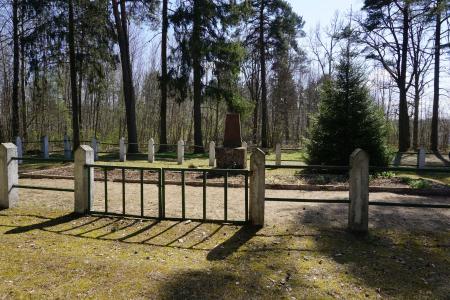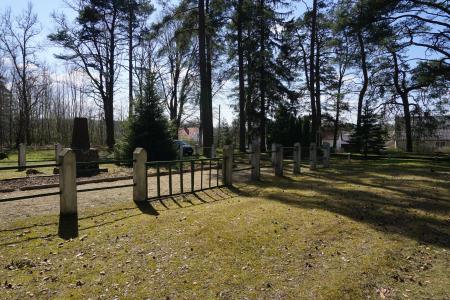Obj. ID: 44152
Jewish Funerary Art Holocaust Memorial Behind the Municipal Cemetery in Aknīste, Latvia, 1960s

Memorial Name
No official name
Who is Commemorated?
Jews of Aknīste, victims of the Holocaust, reburied at this site.
Description:
The monument is situated behind the municipal (Christian) cemetery of Aknīste. Near the mass grave, the graves of Latvian partisans were placed in the 1990s.
The mass grave where the murdered Jews of Aknīste were registered, is surrounded by a metal fence with concrete posts. In the center, there is a red granite stele placed on a high concrete pedestal. On its side facing the mass grave, a Russian inscription reads "Eternal memory to the victims of the fascist terror, 1941."
Inscription
Russian
Вечная
память
жертвам
фашмстского
террора
1941 г.
Translation: Eternal memory to the victims of the fascist terror, 1941.
Commissioned by
Hone Halsmann, the head of the executive committee of the town of Aknīste
sub-set tree:
Arrests of Aknīste Jews began in mid–July 1941. For a couple of days, about 150–170 Jews were imprisoned in the hall of the hotel “Austrija.” Part of them were murdered in the hotel yard on 18 July by the self–defence unit of Ilūkste; the other part was taken to the outskirts of the town – the end of Jaunā Street – and shot there.
After WWII, probably in the early 1950s, the murdered Jews were reiterated in this site, situated behind the municipal cemetery. The family of Leyb Feldhuhn, who lived on the Ganības farm in Asare parish and was killed by “self–defenders” from Ilūkste in July 1941, is also reinterred here (Meler 2010, 29; Meler 2013, 29).
According to the reminiscences of Arnold Kovalevsky, "Mary, Margenik's daughter, married Calit the policeman in 1940/41 and managed to flee into Russia with him. When she returned, she was an initiator of the reburial of the Jews. Khone Halsmann also managed to escape with his parents. When he returned, he was appointed head of the executive committee of the town of Aknīste [=mayor]. He organized the reburial of the Jews near the cemetery. A rabbi was present at the ceremony and read prayers. Khone Halsmann built an iron fence with concrete posts around the common grave. A six-pointed Star of David was etched into the top of each post. The stars were later covered with cement, and Halsmann was removed from his position. After that, he immigrated to Israel" (Meler 2010, 28; Meler 2013, 28).
The monument on the mass grave, however, still had not been built by 1960, as demonstrated by Ilya Lensky, who published correspondence of Girsh Gordon with the authorities. Gordon demanded that the authorities erect a monument on the grave (Lenskis, p. 36-38).
"Holocaust Memorial Places in Latvia," a website by the Center for Judaic Studies at the University of Latvia, http://memorialplaces.lu.lv/memorial-places/zemgale/akniste-municipality-the-akniste-cemetery/.
Lenskis, Ilja, Holokausta piemina Latvijā laika gaitā 1945–2015 = Holocaust Commemoration in Latvia in the Course of Time, 1945–2015 (Riga: Muzejs “Ebreju Latvija,” 2017), pp. 36-38.
Meler, Meyer, Jewish Latvia: Sites to Remember (Tel-Aviv: Association of Latvian and Estonian Jews in Israel, 2013), pp. 27-28.
Meler, Meyer, Mesta nashei pamiati: Evreiskie obshchiny Latvii, unichtozhennye v Kholokoste (Riga: by the author, 2010)













